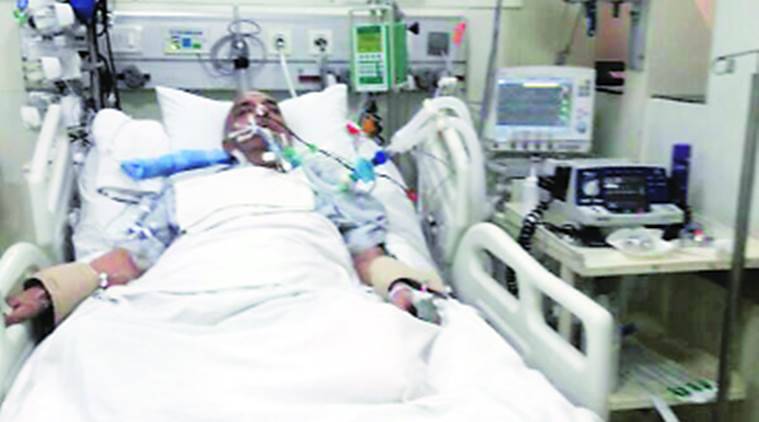|
Getting your Trinity Audio player ready...
|
During this pandemic hospitals all over the country often get overwhelmed by the number of patients seeking medical help. Who get to decide who lives and who dies? Below is an instructive article from the Atlantic.
Coronavirus- December 8, 2020
TrueNewsBlog- TNB
The original “God Committee” had seven members: a surgeon, a minister, a banker, a labor leader, a housewife, a government worker, and a lawyer. They convened in the summer of 1961 in Seattle because a professor of medicine at the University of Washington had invented a new method of dialysis that could indefinitely filter the blood of people whose kidneys were failing.
His device, hailed as the first artificial human organ, resided in an unobtrusive annex of Seattle’s Swedish Hospital, and it seemed like a true medical miracle. Suddenly people with less than a month to live could be restored to health, provided they could be dialyzed regularly. But at the time, roughly 100,000 Americans were dying of end-stage kidney disease. There were hundreds, possibly thousands, of viable candidates. The program could take only 10. Who should get the lifesaving care?
The committee set out to make this choice “with no moral or ethical guidelines save their own individual consciences,” as Life magazine reported. The physicians briefing the group had already narrowed the field by eliminating people older than 45 (because they were more likely to develop complications that would hinder their recovery) and children (on the theory that they weren’t mature enough to handle two 12-hour dialysis sessions a week, and were possibly vulnerable to unpredictable side effects). Beyond that, the committee was on its own.
Its members weighed, among other things, whether the person could afford to live near enough to the hospital to get regular treatment; whether residents of other states should be eligible, considering that Washington taxpayers had partially funded the development of the treatment; whether a chemist or an accountant had the greater “potential of service to society”; whether a candidate was “active in church work”; and, for the married men under consideration, which of their wives could best cope with losing her husband. “A woman with three children has a better chance to find a new husband than a very young widow with six children,” the labor leader remarked.
The results of the deliberations were unsurprising, to an extent: The 10 patients chosen from among the first 17 who came before the committee lived; the others died. To this day, we know the seven committee members only by their professions, a Chaucerian feature that makes this story feel more like a fable than a piece of science history.
It was eerie to stumble across the God Committee—also known as the “Life or Death Committee”—last spring, when I was following the story of a different artificial organ. In New York, the nightmare scenario being discussed on the radio, in the bodegas, on TV was that the hospitals, overwhelmed with COVID‑19 patients in respiratory failure, would run out of ventilators. Reports from northern Italy gave a grim preview: angst-ridden medical teams arbitrating which patients would get to breathe and which would be consigned to die. Governor Andrew Cuomo was on national television begging the federal government for more ventilators and personal protective equipment.
Article after article outlined a series of awful questions: If and when New York hospitals ran out of ventilators, should the machines be allotted on a first-come, first-served basis? Based on who was sickest? Based on who was most likely to survive? Based on who, if they survived, had the most years left to live? Based on some randomized lottery system?
As it happens, the job of answering these questions is still frequently left to committees. But today, “the lawyer, the housewife, the banker, the minister” have been supplemented by bioethicists. “New York’s Bioethics Experts Prepare for a Wave of Difficult Decisions,” read the headline of a March 28 Washington Post article. “Who Should Be Saved First?” The New York Times asked, pointing out that “well before rationing caused by coronavirus, protocols were established about ‘who lives and who dies.’ ”
The article was right—there were protocols, written by committees of ethicists, physicians, lawyers, clergy, philosophers, community activists, and political scientists. In New York, guidelines for allocating ventilators in a pandemic had been designed by the New York State Task Force on Life and the Law, which used the 1918 flu as a model. These guidelines were part of a plan for “crisis standards of care,” or protocols for handling a public-health emergency that outstrips the medical system’s capacity. Published in 2015, the task force’s plan envisioned the transfer of equipment, personnel, and patients among hospitals to ensure that one institution wasn’t overrun while others had empty beds.
Last March, as the coronavirus took hold, the committee met with the state’s health commissioner to brainstorm ideas for COVID-specific protocols. Despite that meeting, its key recommendations were never taken; no crisis standards of care were implemented in New York. These standards can be initiated only by the government—a process that, in most states, including New York, requires a declaration from the governor. This left the clinical ethicists staffing New York’s hospitals—along with the doctors and nurses and administrators—to figure out rationing themselves.
“At a certain point, I realized the ambulance is the score of this movie,” Joseph J. Fins, the chief of medical ethics at the Weill Cornell Medical Center in Manhattan and one of the leading figures in the field, told me in October. He lives down the street from his hospital, and by late March the wail of sirens had become an unending drone, day and night. He and his team of ethicists were on call 24/7, trying to support physicians, nurses, and administrators through the initial COVID‑19 surge. “Our world became 69th Street,” Fins said.
The doctor had five patients, two intubation teams, and not very much time. What do I do? the physician pleaded.
Fins is an affable 61-year-old with an easy smile and a calm, teacherly aspect. He wore a crisp white shirt and a tie for both of our video interviews, despite being home in his apartment. More than once in our conversations, he referenced Thucydides. An internist as well as a bioethicist, Fins serves on the task force that in 2015 came up with ventilator-allocation guidelines for New York. “Our analysis was anticipatory and a tabletop exercise,” he wrote in an academic journal in June. “It was not the real deal.”The real deal was almost beyond imagining.
During the eight weeks of the surge, Fins’s team members at Weill Cornell worked around the clock, providing 2,500 ethics consultations and addressing a range of horrific questions they’d never previously encountered. Fins likened the influx of critical-care patients to what you’d expect if there had been “a major plane crash at LaGuardia Airport”—only the influx never stopped. Patients just kept coming. Hospital staff needed to know how to triage. “We were approaching the hinterland of chaos.”
Kasey Grewe: Headlines don’t capture the horror we saw.
Physicians in the emergency department were begging Fins for the authority to withhold CPR when they felt it was futile; they wanted to be able to focus their care on patients with better odds of surviving, and to avoid the viral transmission that CPR can cause. But since 1987, New York State law has generally held that physicians must try to resuscitate a patient, unless the patient has a “do not resuscitate” order. Hospitals could have, in theory, made an argument for suspending doctors’ obligation to follow that law given the crisis circumstances.
(The prosecution of health-care workers after Hurricane Katrina is seen as a disastrous example of what happens when doctors work without legal clarity regarding their end-of-life decision making during a crisis.) Fins’s team quickly wrote 12 different versions of a triage protocol, hoping to anticipate whatever guidelines might come from the New York State Department of Health—but no guidelines ever came.
“This was a stress test for medical ethics, for distributive justice and the allocation of scarce resources,” he wrote. “Simply put, there were more patients to be resuscitated than available personnel, much less equipment.” As far as we know, New York hospitals never ran out of ventilators, but the state did experience terrible shortages of PPE, of staff, of crucial equipment and supplies. In March, PPE was so scarce on the ground in New York City that pictures surfaced of nurses wrapping themselves in trash bags. At hospitals across the city and state, the shortage contributed to the policy of prohibiting all visitors. It wasn’t acceptable to, say, risk depriving a nurse of PPE in order to provide the gear to visitors, whom the hospitals were ethically obliged to protect from exposure, for their own sake and to limit community spread.
Hospitals faced other urgent and difficult questions. Physicians needed to know: What do we do when we have a COVID‑19 patient who wants to be discharged against medical advice but who would be returning to a home where she cannot isolate from others? Can we sequester patients over their objections? Is using physical restraints justifiable if people resist being quarantined?
Comparable questions and shortages now confront hospital systems around the country, as COVID‑19 cases spike all over. Questions of rationing have emerged again, in Utah and elsewhere, reprising the grisly experience of last spring.
In New York, staff ethicists became lifelines for frightened colleagues who were “surrounded by 10 to 15 critically ill intubated patients in the emergency department, while the patients’ panicked relatives sat nervously in a (virtual) waiting room, anxiously expecting news of their loved one,” Fins later wrote in The Journal of Clinical Ethics.






